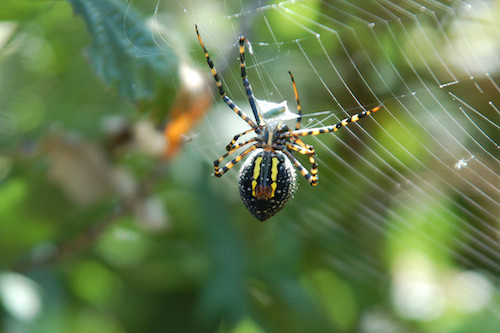 Evolution
Evolution
 Intelligent Design
Intelligent Design
If Nature’s Designs Weren’t So Good, Engineers Wouldn’t Be Rushing to Imitate Them

We’ve reported on biomimetics many times, but the news keeps flooding in. Here are just a few recent examples of new science projects that seek to imitate nature:
- Spiders: In the future, soldiers may wear bulletproof vests made of spider silk produced by genetically engineered silkworms. (Live Science)
- Prunes: To reduce drag on an airplane or car hood, make like a prune. (New Scientist)
- Balsa: Engineers at Harvard have created a lightweight honeycomb material that mimics the material performance of balsa wood. (Harvard News)
- Muscles: At the University of Arkansas, researchers have engineered a "muscle mimic" scaffold that supports the repair of skeletal muscle tissue.
- Cell membranes: Finding that proteins in the nuclear pore act like Velcro, biochemists at the University of Basel envision nanomachines that could use the principle for applications like "nanoscale conveyor belts, escalators or tracks."
- Honeycomb: Envious of how bees, sponges, and plants make ultralight, ultrastiff materials, researchers at Lawrence Livermore and MIT publishing in Science report progress in using similar construction processes to improve "mechanical metamaterials."
- Moths: In Switzerland, engineers at EMPA are making better solar cells by "recreating a moth’s eye to drastically increase its light collecting efficiency."
- Flies: By reverse engineering the ocelli of flying insects (eyes that measure optic flow), bioengineers at Harvard and MIT were able to stabilize a fly-sized drone. (Royal Society)
- Ants: By studying how ants link up to cross streams and deal with floods, scientists at Georgia Institute of Technology think they "could inspire the development of robots and smart materials that assemble into new structures," according to Nature.
- Human eyes: By mimicking the curvature of the human retina, Sony engineers created a curved CMOS sensor with improved light-gathering and focusing performance that represents a "great leap forward in digital imaging technology." (PhysOrg)
The list goes on. Two things are notable from it. One is the variety of living organisms (vertebrates, invertebrates, plants, cells) that are inspiring human intelligent design.
Those other sources of inspiration include geckos, octopuses, elephants (flexible trunks), mussels and barnacles (waterproof glue), lotus leaves, the Venus flytrap, birds (flexible wings, feathers, tricks with light), earthworms, lobsters, hummingbirds, termites, maple seeds, bombardier beetles, dragonflies, jellyfish, oysters, shark skin, cellular nanomachines like ATP synthase and flagella, whale flippers, fireflies, beetles (dew collection and shiny coats), butterflies (wing scale colors), bats, wasps, fish, zebras, woodpeckers, starlings, hagfish, turkeys, cuttlefish, sea snakes, geese, shrimp, algae, viruses (packing motors), sea turtles, snails, salamanders, cockroaches, frogs, tropical fruit trees, owls, penguins, stingrays, bacteria, roses, and much more.
The other thing is the variety of institutions actively involved in bio-inspired engineering (Harvard, MIT, Lawrence Livermore, universities in Georgia, Arkansas, California and Switzerland, and technology companies like Sony).
There were nature-inspired products in the last century (Velcro being a classic example), but biomimetics really caught on in the last decade or so. It’s now an international gold rush. Its hidden assumption? Intelligent design. Good engineering is worth reverse engineering.
If Darwinism were the assumption, researchers would just let objects sit around and mutate for millions of years then see what turns up. Good luck with that.
